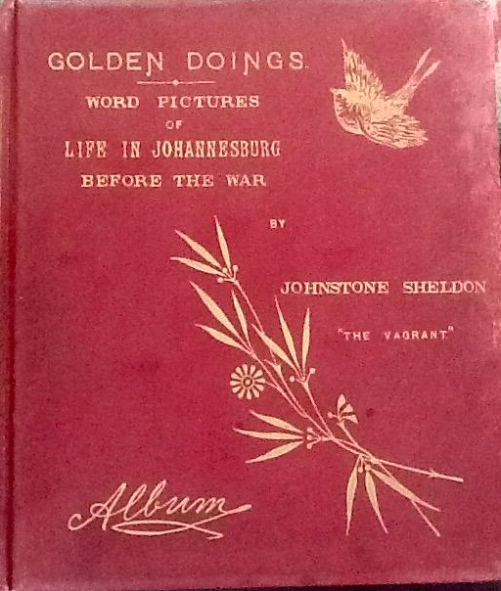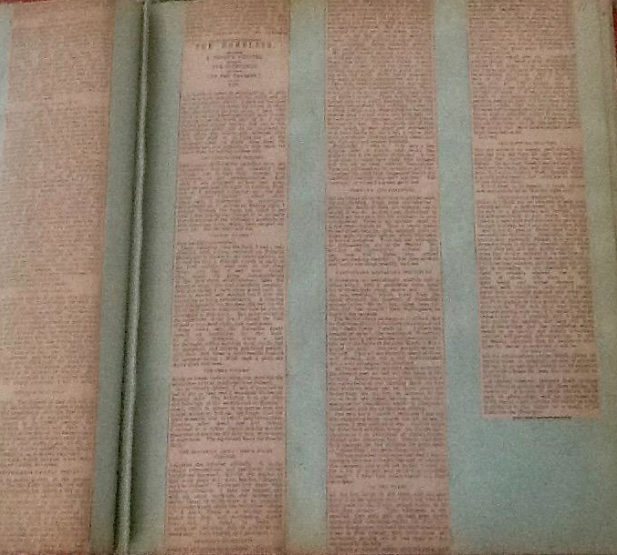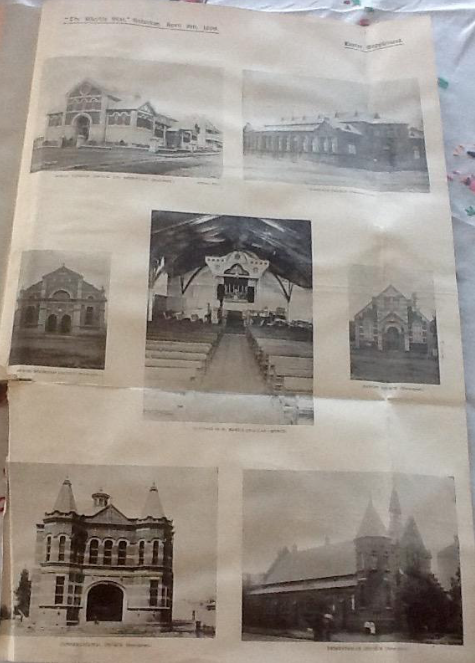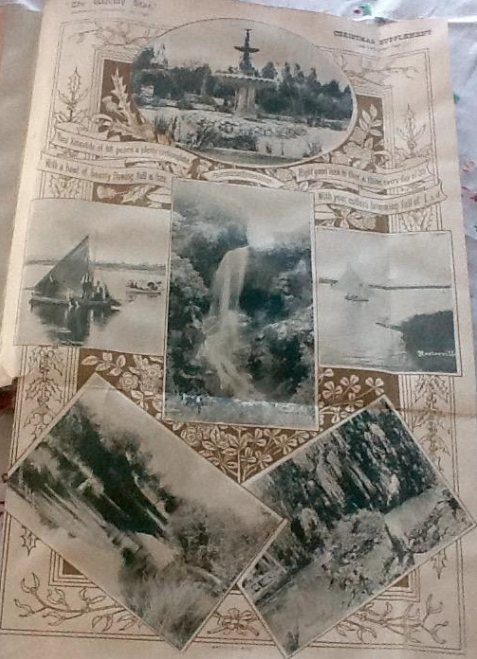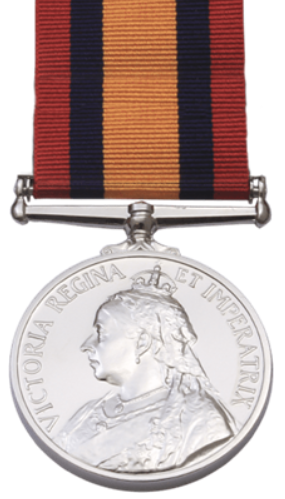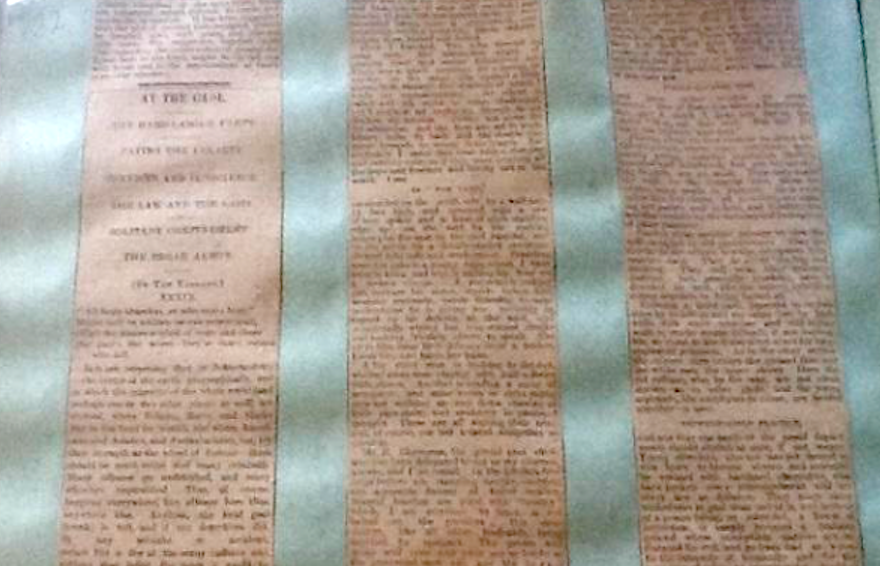
The date of this book is unknown but the internal evidence pinpoints the volume to the years 1896 to 1899. The size is 25x30cm. The cover is an eye catching gold printing on pebbled dark maroon cloth, gilt edges, scuffing to edges, each page specially attached. The book contains laid down newspaper cuttings of Johannesburg life in the late 19th century. The author of these Weekly Star contributions was Johnstone Sheldon who wrote under the pseudonym The Vagrant. The album holds 96 of his pre South African War (Second Anglo-Boer War 1899 - 1902) columns.
Book Cover
It appears as though the album was commissioned by Sheldon to preserve his newspaper writing. Here is an example of collectable ephemera which is difficult to price because it is unique. It was my pleasure to become the new owner of the album. I found it while browsing at the Frank Thorold book farm out at Kya Sands. It is one of those rare treasures that one is lucky enough to stumble upon. I was welcomed by the well-known fashion photographer Merwelene van Der Merwe, the new owner of Frank Thorold’s books, who has sadly taken the decision to sell the entire Frank Thorold - Robin Fryde - Neillen Van Kraayenberg collections. The sale started about six months ago but there are still many incredible books remaining. It was an enormous quantity of rare and unusual books, pamphlets, maps, newspapers, paper ephemera, reputed to comprise some 150 000 items. Extraordinary books have come onto the market to bring pleasure and pride of ownership to the next generation of custodians of these treasures.
The pages of the album are a faded, insipid green and the newspaper columns are a pale shade of pink. It is a volume that reveals something about newspaper printing in early Johannesburg. At the same time the subject matter and themes pursued week after week by Sheldon give us a glimpse of what life in Joburg was like in the pioneering days of the 1890s. It is an unusual volume of newspaper clippings that would otherwise only survive in the vast collection of old newspapers in the Johannesburg Public Library. The compilation of an album makes for a far more accessible resource.
Example of a page from Golden Doings by Johnstone Sheldon
I believe that this is a volume that should be reprinted so it can be more widely known and used. I have numbered the pages of the album and compiled an index of the 96 columns (if anyone is interested I am more than happy to share this). I plan to offer Wits' Historical Papers a scan of the album to ensure the preservation of this extraordinary resource.
Sheldon wrote about all aspects of life in Johannesburg roughly between the years 1896 and 1899 following his arrival from Australia. One presumes he found work on the Weekly Star and remained a journalist in Johannesburg until the outbreak of the War. He travelled widely over the social scene. His interest lay in the life of the poor, the working man, the underclass. He was the champion of the man and woman who undertook menial jobs - the brickmaker, the nurse, the working miner, the shop girl, the baker, the firefighter, the laundress, the barber and the hairdresser. His was a campaign for social justice. He was curious about people, how and where the poor lived (the mine boarding houses, the cheap lodging houses, night shelters at 9d a night, a location etc.). He wrote about labour disputes, life in the hospital, the coolie location (sic), how people died (E.g. The Braamfontein Explosion) and where they were buried. He promoted the work of the early social workers, churches and philanthropists of the town, for example, Nazareth House, Saint Monica’s home, Sister Rosa, the Salvation Army, Mr Kelly’s home etc. Sheldon also explored the social institutions of the day - the churches, the gaol, the hospital, the racecourse, the social and musical clubs, the sports clubs, the Witwatersrand Agricultural Show and more. He poked and probed across the town as a true vagrant.
The churches of Johannesburg of the late 1890s. Only St Mary’s (now called St Mary’s the Less) remains today.
Sheldon also wrote about the unacceptable living conditions in Johannesburg in the late 1890s - the insanitary situation (Johannesburg had a very high death rate from typhoid because of poor water management). He visited the meat market and commented on the rise in the price of meat because of the rinderpest epidemic.
Some of his columns are little gems. There is a fine piece about the Market Gardeners of Johannesburg; how the Portuguese are the producers, the Italians are industrious, the Chinese are cautious and he provides a description of Zoccola’s farm - Lombardy - today’s Lombardy East. There is an account of a day in Durban (he travelled by train) and a description of celebrating the American Day of Independence.
His writing is interesting but somewhat earnest, stolid, florid, verbose and filled with detail. Most important for the eye witness are accounts of the on the spot observer. He was the master of alliteration - 'prayer and praise', 'pleasure profit and possibilities', 'barbers and baldness', 'unknown and unnoticed', 'gold and grain', 'the law and the lash' all feature in his writing.
It is quite a task to read a Sheldon column from beginning to end. We learn about the details of working for £1 a day or £6 a week. There is one delightful column about going to the races in early Johannesburg. Other topics include attending a dog show of the Kennel Club, the Christmas picnic spots in and around the town by 1898 and spending a day in the court. Sheldon also has his prejudices reflecting the social mores of his time. He may have supported the underdog but his working man was likely to be white working class; he supported trade unionism but for a white working class. He saw Chinese immigrants as cunning and possibly threatening with their gambling dens and their grocery stores. For Sheldon the coming of black miners posed a threat to the white immigrant miner.
Recommended Christmas picnic spots in 1898 included Joubert Park, Auckland Park lake, Rosherville, Florida Lake and Muldersdrift
The Star newspaper appeared for the first time in Johannesburg as The Eastern Star. It was founded in Grahamstown under that title on 6 January 1871 and was moved to the Witwatersrand in 1887 by the brothers Thomas and George Sheffield, the then owners. In 1889, the name Eastern Star was changed to The Star. The Star still appears as a daily paper and there is also a Saturday Star. It is currently owned by Iqbal Surve, chairman and active owner of Independent Media. The Star’s great slogan was the byline “telling it like it is“ and here is a superb collection of writing about Johannesburg, like it was in the 1890s. An excellent and popular history of The Star was the centenary volume, Like it Was, The Star 100 Years in Johannesburg, published in 1986 (edited by James Clarke). Chapters 1 and 2 of this book give a taste of Johannesburg in the period 1886 to 1900. Here is another view of the world of Sheldon. Here too the Dynamite explosion of 1896 and the impact of the Rinderpest epidemic were graphically recounted. In January 1896 the news of the day was the political crisis of the Jameson Raid but The Star wrote it up as “not an unconditional surrender” by Jameson and his column. By April 1896 Jameson had become a waxwork figure at Lingard’s art Waxworks. In 1897, the “invention of the age” (the motor car or horseless carriage) was exhibited at Berea Park.
I have also discovered, but only too late, that there was a second album of newspaper cuttings of Johnstone Sheldon called Johannesburg Golden Doings Word Pictures of Life in Johannesburg after the War and that this was listed in the auction catalogue of Westgate Walding in February 2018. I presume it was then sold. If anyone reads this contribution and through good luck and chance can put me in touch with the new owner of that second volume of cuttings, we may well be able to arrange for copies to be made and an exchange and sharing of information to happen. It is a shame that the two volumes of cuttings have now been separated.
Of course I wanted to know more about Sheldon. Online genealogical information provides the bare bones. He was born in circa 1865 in Ballarat, Victoria, Australia. He was the son of Joseph Sheldon and Jane Smith. He had three brothers, Ernest George Sheldon, Joseph Sheldon and Herbert Sheldon. Johnstone Sheldon was a journalist; he worked for the Ballarat Star newspaper for four years. The first of the family to emigrate to South Africa in 1895 was Joseph Sheldon (born 1863). In November 1895, Johnstone Sheldon and his younger brother, Herbert (born 1875), left Melbourne and sailed for South Africa on board the S.S. Damascus. Their final destination was Johannesburg. (click here for more biographical details).
Sheldon evidently remained in South Africa at least until the Boer War. We know he was present with General William Gatacre's forces at the Battle of Stormberg on 10 December 1899, the first British defeat in what was called “the Black week”. It seems that at this encounter, Sheldon received a "brand of a bullet across his brow". (Source: "Interview with a London Pressman", 28 June 1900, pg. 39, Otago Witness, Issue 2416, New Zealand)
Evidence suggests that Sheldon worked as a war correspondent for the Daily Chronicle of London and also for the Argus in Cape Town. It appears as though he was awarded a QSA (Queen’s Service Award) on 16 February 1903. (Source: "War Correspondents", AngloBoerWar.com)
The QSA Medal. Note it was not without some controversy that certain war correspondents became eligible for the award of this Anglo-Boer War British Medal (Source: QSA Medal roll).
Whether to award QSAs to correspondents was discussed in 1901 with the decision made to issue medals under certain circumstances in December 1901. The discussions are contained in WO 32/8559. It is noted that to be eligible for a war medal, the correspondent must:
- Be accredited by the editor of the newspaper he represents
- Have reported by telegraph and not by letter
- Held a pass from the Chief Censor
- Have served with troops in the field
Sheldon is briefly mentioned in Frederic William Unger's 1901 book, With 'Bobs' and Krüǵer: "Captain Tennant introduced me to two other correspondents, Mr. Sheldon, of the Cape Argus, and Mr. Swallow, of the Central News Company."
In 1900, Sheldon visited both Wellington, New Zealand and Sydney, Australia to lecture on the Second Anglo-Boer War and South Africa. The New Zealand Evening Post reported in June 1900 that "Mr. Sheldon has had to relinquish his work owing to the strain having told upon his health, and he is taking a round trip as a means of recuperation." (Source: "A War Correspondent's Lecture", 14 June 1900, pg. 6, Evening Post, Volume LIX, Issue 140, New Zealand).
Although the New Zealand Evening Post ran the breathless advertisement promoting Sheldon's lecture (Source: Page 6 Advertisements Column 1, 15 June 1900, pg.6, Evening Post, Volume LIX, Issue 141), the resulting review was not favorable:
The major portion of Mr. Sheldon's lecture had to do with the Stormberg disaster but he threw no new light upon what he himself termed the most inexplicable affair of the war. Throughout the lecture there was much word-painting but very little statement of instructive matters of fact. (Source: "A Lecture on the War", 16 June 1900, pg.5, Evening Post, Volume LIX, Issue 142, New Zealand.)
The Australian audience was no more sympathetic and one newspaper report read:
"Visiting South African journalist Johnstone Sheldon, who had been on the Johannesburg Star at the start of the war and who became Special War Correspondent of the London Daily Chronicle and Cape Argus, gave four lectures at the Palace Theatre in June 1900. He brought '100 realistic limelight' views of the 'grand and rugged scenery' to his analysis of the battle of Stormberg. The colonists, echoing Archibald Forbes' view that they were a practical people concerned for their own advantage, were more interested in the information contained in the pictures on the potential of southern Africa for settlement and trade than in Sheldon's 'patriotic appeals'.
The Anglo-Boer War marked a clear dividing line in the life of Johnstone Sheldon. Tracking back to the album of Life in Johannesburg, the columns reveal that Johnstone quickly threw himself into life of a new corner in a rough mining town, perhaps not that different from his hometown of Ballarat. Within the social constraints and conventions of his day his columns reveal him to have been a social investigator, a humane man, a documenter of the social scene and a curious reporter. His writing has something of the flavour of a Henry Mayhew in Johannesburg. Mayhew (1812-1887) was the London journalist, researcher and campaigner for social reform who wrote about London life and the London poor in a series of newspaper articles published in the Morning Chronicle.
I have not picked up further trace of Johnstone Sheldon after the Boer War. I urgently need his second volume of columns to source the man and his view of the changing town of the Edwardian period.
Kathy Munro is an Honorary Associate Professor in the School of Architecture and Planning at the University of the Witwatersrand. She enjoyed a long career as an academic and in management at Wits University. She trained as an economic historian. She is an enthusiastic book person and has built her own somewhat eclectic book collection over 40 years. Her interests cover Africana, Johannesburg history, history, art history, travel, business and banking histories. She researches and writes on historical architecture and heritage matters. She is a member of the Board of the Johannesburg Heritage Foundation and is a docent at the Wits Arts Museum. She is currently working on a couple of projects on Johannesburg architects and is researching South African architects, war cemeteries and memorials. Kathy is a member of the online book community the Library thing and recommends this cataloging website and worldwide network as a book lover's haven.

